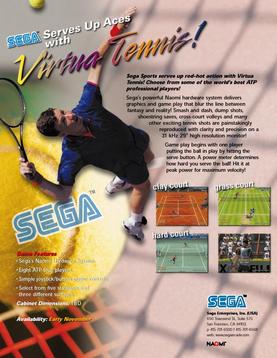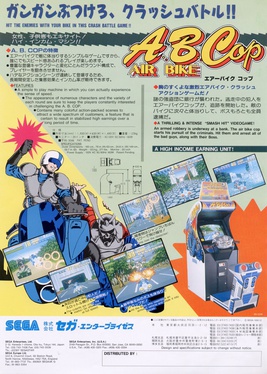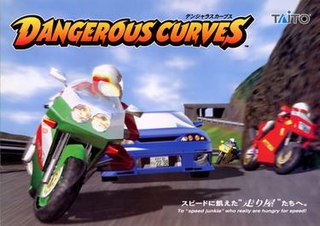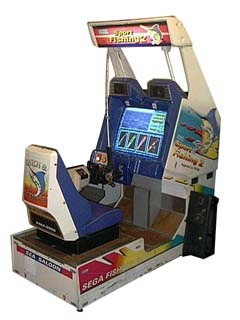
Virtua Tennis, known in Japan as Power Smash, is a 1999 tennis arcade game created by Sega. The player competes through tennis tournaments in an arcade mode. It was ported to the Dreamcast in 2000, and to Windows in 2002. A Game Boy Advance version was also released in 2002, followed by an N-Gage version in 2003. For the home console market, the game was expanded with the introduction of the campaign mode.

Sega AM Research & Development No. 3, known as Hitmaker Co., Ltd. from 2000 to 2004, is a defunct division of Sega, a Japanese video game company. Established by 1993, AM3 was managed by Hisao Oguchi and developed a number of arcade games for Sega. Series introduced by AM3 include Virtual On, Sega Rally, Crazy Taxi, and Virtua Tennis. AM3's main focus was on arcade games until the release of the Dreamcast. Additionally, developers Tetsuya Mizuguchi and Kenji Sasaki developed Sega Rally Championship with AM3 before departing to form AM Annex, which later split into Sega AM9 and Sega AM5.

Virtua Racing or V.R. for short, is a Formula One racing video game developed by Sega AM2 and released for arcades in 1992. Virtua Racing was initially a proof-of-concept application for exercising a new 3D graphics platform under development, the "Model 1". The results were so encouraging that Virtua Racing was fully developed into a standalone arcade title.

Sega AM Research & Development No. 2, previously known as SEGA-AM2 Co., Ltd., is a video game development team within the Japanese multinational video game developer Sega. Yu Suzuki, who had previously developed arcade games for Sega including Hang-On and Out Run, was the first manager of the department.

Virtua Fighter 2 is a 1994 fighting video game developed by Sega. It is the sequel to Virtua Fighter (1993), and the second game in the Virtua Fighter series. It was created by Sega's Yu Suzuki-headed AM2 and was released for arcades in 1994. Ports were released for the Sega Saturn in 1995 and Microsoft Windows in 1997.

The Lost World: Jurassic Park is a light gun arcade game from Sega. It was released in 1997, and is based on the film of the same name. It is also a sequel to Sega's 1994 Jurassic Park arcade game. A third Jurassic Park arcade game, based on Jurassic Park III, was made by Konami in 2001.

Rad Mobile is a racing arcade game developed by Sega AM3 and published by Sega. It was first published in Japan in October 1990, followed by an international release for arcades in February 1991. Rad Mobile was Sega's first 32-bit game, using Sega's System 32 arcade system board. It was also the first appearance of Sonic the Hedgehog, who appears as an ornament hanging from the driver's rearview mirror.

A.B. Cop is a futuristic 3D racing arcade game released by Sega in 1990. It never received any official port to home consoles.

Ace Driver is a 1994 racing arcade game developed and published by Namco. The player controls a Formula One racer, with the objective being to complete three laps of a race course and to avoid a collision with opponents and other obstacles. Three difficulty levels are available, as is a mode to enable a gear shift. Similar to Namco's own Final Lap series, the arcade cabinet can be linked together with another unit to enable eight-person multiplayer. It ran on the Namco System 22 arcade hardware.

Alpine Racer is a racing sports video game developed and published by Namco for arcades. It had a limited release in December 1994, followed by a wide release in July 1995. It ran on the Namco System 22 arcade hardware.

Monaco GP is an arcade racing game released by Sega in November 1979 in Japan, and January 1980 worldwide. An upgraded version, Pro Monaco GP, was released later in 1980. One of the last Sega games to use TTL chips instead of a microprocessor CPU, the game has players race against a clock and pass rival racers while attempting to earn points driving through five areas.
Mie Kumagai is a Japanese video game producer. She began working at Sega in 1993 as an amusement park attraction planner and transferred to the arcade division of its AM3 studio two years later. When this studio's boss, Hisao Oguchi, was promoted to president of the whole company in 2003, Kumagai became the new AM3 head and the first ever female president within Sega's development structure or any Japanese development studio. She produced a number of arcade titles before helming Sega's successful Virtua Tennis series for arcades and home consoles. As of 2015, Kumagai is an executive producer at the mobile game company Colopl.

DecAthlete, released in Europe as Athlete Kings due to a licensing issue, is a track-and-field themed arcade sports video game. On its unveiling, the gaming media generally described it as a modern clone of Daley Thompson's Decathlon. Released in 1996, it was developed by Sega AM3 and produced by Sega. A home port was released on the Sega Saturn in 1996, largely identical to the arcade version, due to the similar hardware of the ST-V hardware and the Saturn. It was released on the PlayStation 2 in Japan only as part of the Sega Ages 2500 series. Compared to other decathlon based games, Decathlete has a more comic and cartoon-like style. A sequel followed in 1997, which was the winter sports-based Winter Heat.
Hisao Oguchi is a Japanese business executive. He was director, vice chairman, and chief creative officer of Sega Sammy Holdings Inc. Oguchi originally was President and CEO of Sega. He was president and CEO of Sega Sammy Creation. He is currently a director of UDream, a content production company.

This is a list of development studios owned by Sega, a Japanese video game developer and publisher based in Tokyo, Japan. Accompanied with the list is their history of game development. Also included are the companies that Sega has acquired over the years. For a full list of games developed and published by Sega, see List of Sega video games, List of Sega mobile games and List of Sega arcade games.

Sega Sports Research and Development or Sega Sports R&D was a development division of the Japanese video game company Sega. It was previously known as Smilebit, one of nine semi-autonomous studios which Sega established in 2000. Smilebit was previously known as R&D6 or AM6 which itself was mainly based on Sega PC. Smilebit was known for its sports simulation titles, as well as Jet Set Radio. When Sega started releasing games for other platforms, Smilebit began developing games for the Xbox, with Jet Set Radio Future, Panzer Dragoon Orta and GunValkyrie. Smilebit was led by Shun Arai as president and Takayuki Kawagoe as director. Kawagoe became president of Smilebit in 2003.

Dangerous Curves is an arcade racing game developed and published by Taito. The arcade cabinet is constructed to allow players to choose between simulating either a car or a motorcycle and then race other vehicles on a variety of courses.

Sport Fishing 2 is a fishing simulation video game developed by Ryobi and published by Sega for the arcades in 1995. It is the sequel to Sports Fishing (1994).

Ryu Ga Gotoku Studio is a video game developer housed within the Japanese video game company Sega as part of its Sega CS Research and Development No. 1 division. It is known for developing the games in the Like a Dragon series, which the studio is named after, since Yakuza 5.
VR-1 is a virtual reality amusement park attraction released by Sega. Installed publicly for the first time in July 1994 at the opening of the original Joypolis indoor theme park, Yokohama Joypolis, it represented the culmination of Sega's Japanese AM teams and the Virtuality Group's collaborative developments in the field of VR. In 1996 and 1997, respectively, it was also installed at SegaWorld London and Sega World Sydney.
















